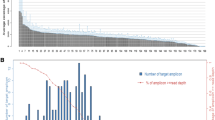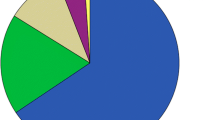Abstract
To use the semiconductor sequencing platform (SSP) to analyze the gene mutate spectrum of breast cancer patients. We recruited 46 breast cancer patients, and detected the ER/PR/HER2 expression level of the tumor tissue by immunohistochemistry. In addition, combined with SSP technology, we detected 207 hot mutation regions of 50 breast cancer related genes with multiple polymerase chain reaction (PCR) technology. There were 8 cases of grade I, 18 cases of grade II, 20 cases of grade III in 46 breast cancer patients according to histological grade and 12 cases of ER/PR + HER2 +, 18 cases of ER/PR + HER2−, 13 cases of ER/PR - HER2 +, 20 cases of ER/PR − HER2− according to ER/PR/HER2 status classification. Moreover, we found that there were 33 gene locus mutations of 8 genes including AKT1, APC, BRAF, CDKN2A, KRAS, PTEN, PIK3CA and TP53, but difference was not statistically significant (P > 0.05) when compared these gene mutations (except for PIK3CA) in each groups according to the histological classification of breast cancer and the ER/PR/HER2 classification. PIK3CA mutation rate of grade I was obviously higher than that of grade II ~ III histological grading in breast cancer patients (P < 0.05). Based on our results, we drew a conclusion that the occurrence and development of breast cancer was a process involved multiple genes. Here, we found that PIK3CA played a role in the development of the early stage of breast cancer, which could provide clinical basis for treatment of breast cancer. Moreover, SSP technology could be an effective and sensitive method for detection of gene mutation spectrum in breast cancer.

Similar content being viewed by others
References
Cancer Genome Atlas Network (2012) Comprehensive molecular portraits of human breast tumours. Nature 490:61–70
Fan L, Strasser-Weippl K, Li JJ, St Louis J, Finkelstein DM, Yu KD, Chen WQ, Shao ZM, Goss PE (2014) Breast cancer in China. Lancet Oncol 15: e279–289
Banin Hirata BK, Oda JM, Losi Guembarovski R, Ariza CB, de Oliveira CE, Watanabe MA (2014) Molecular markers for breast cancer: prediction on tumor behavior. Dis Markers 2014:513158
van de Vijver MJ, He YD, van't Veer LJ, Dai H, Hart AA, Voskuil DW, Schreiber GJ, Peterse JL, Roberts C, Marton MJ, Parrish M, Atsma D, Witteveen A, Glas A, Delahaye L, van der Velde T, Bartelink H, Rodenhuis S, Rutgers ET, Friend SH, Bernards R (2002) A gene-expression signature as a predictor of survival in breast cancer. N Engl J Med 347:1999–2009
Kittaneh M, Montero AJ, Gluck S (2013) Molecular profiling for breast cancer: a comprehensive review. Biomark Cancer 5:61–70
Roy-Chowdhuri S, de Melo Gagliato D, Routbort MJ, Patel KP, Singh RR, Broaddus R, Lazar AJ, Sahin A, Alvarez RH, Moulder S, Wheler JJ, Janku F, Gonzalez-Angulo AM, Chavez-MacGregor M, Valero V, Ueno NT, Mills G, Mendelsohn J, Yao H, Aldape K, Luthra R, Meric-Bernstam F (2015) Multigene clinical mutational profiling of breast carcinoma using next-generation sequencing. Am J Clin Pathol 144:713–721
Lundin J, Lundin M, Holli K, Kataja V, Elomaa L, Pylkkanen L, Turpeenniemi-Hujanen T, Joensuu H (2001) Omission of histologic grading from clinical decision making may result in overuse of adjuvant therapies in breast cancer: results from a nationwide study. J Clin Oncol 19:28–36
van 't Veer LJ, Dai H, van de Vijver MJ, He YD, Hart AA, Mao M, Peterse HL, van der Kooy K, Marton MJ, Witteveen AT, Schreiber GJ, Kerkhoven RM, Roberts C, Linsley PS, Bernards R, Friend SH (2002) Gene expression profiling predicts clinical outcome of breast cancer. Nature 415:530–536
Ivshina AV, George J, Senko O, Mow B, Putti TC, Smeds J, Lindahl T, Pawitan Y, Hall P, Nordgren H, Wong JE, Liu ET, Bergh J, Kuznetsov VA, Miller LD (2006) Genetic reclassification of histologic grade delineates new clinical subtypes of breast cancer. Cancer Res 66:10292–10301
Lips EH, Michaut M, Hoogstraat M, Mulder L, Besselink NJ, Koudijs MJ, Cuppen E, Voest EE, Bernards R, Nederlof PM, Wesseling J, Rodenhuis S, Wessels LF (2015) Next generation sequencing of triple negative breast cancer to find predictors for chemotherapy response. Breast Cancer Res 17:134
Almendro V, Fuster G (2011) Heterogeneity of breast cancer: etiology and clinical relevance. Clin Transl Oncol 13:767–773
Ariga R, Zarif A, Korasick J, Reddy V, Siziopikou K, Gattuso P (2005) Correlation of her-2/neu gene amplification with other prognostic and predictive factors in female breast carcinoma. Breast J 11:278–280
Sneige N, Hess KR, Multani AS, Gong Y, Ibrahim NK (2017) Prognostic significance of equivocal human epidermal growth factor receptor 2 results and clinical utility of alternative chromosome 17 genes in patients with invasive breast cancer: a cohort study. Cancer 123:1115–1123
Paik S, Shak S, Tang G, Kim C, Baker J, Cronin M, Baehner FL, Walker MG, Watson D, Park T, Hiller W, Fisher ER, Wickerham DL, Bryant J, Wolmark N (2004) A multigene assay to predict recurrence of tamoxifen-treated, node-negative breast cancer. N Engl J Med 351:2817–2826
Cantley LC (2002) The phosphoinositide 3-kinase pathway. Science 296:1655–1657
Berns K, Horlings HM, Hennessy BT, Madiredjo M, Hijmans EM, Beelen K, Linn SC, Gonzalez-Angulo AM, Stemke-Hale K, Hauptmann M, Beijersbergen RL, Mills GB, van de Vijver MJ, Bernards R (2007) A functional genetic approach identifies the PI3K pathway as a major determinant of trastuzumab resistance in breast cancer. Cancer Cell 12:395–402
Bhat-Nakshatri P, Goswami CP, Badve S, Magnani L, Lupien M, Nakshatri H (2016) Molecular insights of pathways resulting from two common PIK3CA mutations in breast Cancer. Cancer Res 76:3989–4001
Mayer IA, Arteaga CL (2014) PIK3CA activating mutations: a discordant role in early versus advanced hormone-dependent estrogen receptor-positive breast cancer? J Clin Oncol 32:2932–2934
von Minckwitz G, Schneeweiss A, Loibl S, Salat C, Denkert C, Rezai M, Blohmer JU, Jackisch C, Paepke S, Gerber B, Zahm DM, Kummel S, Eidtmann H, Klare P, Huober J, Costa S, Tesch H, Hanusch C, Hilfrich J, Khandan F, Fasching PA, Sinn BV, Engels K, Mehta K, Nekljudova V, Untch M (2014) Neoadjuvant carboplatin in patients with triple-negative and HER2-positive early breast cancer (GeparSixto; GBG 66): a randomised phase 2 trial. Lancet Oncol 15:747–756
Payne SN, Maher ME, Tran NH, Van De Hey DR, Foley TM, Yueh AE, Leystra AA, Pasch CA, Jeffrey JJ, Clipson L, Matkowskyj KA, Deming DA (2015) PIK3CA mutations can initiate pancreatic tumorigenesis and are targetable with PI3K inhibitors. Oncogenesis 4:e169
Liang X, Lau QC, Salto-Tellez M, Putti TC, Loh M, Sukumar S (2006) Mutational hotspot in exon 20 of PIK3CA in breast cancer among Singapore Chinese. Cancer Biol Ther 5:544–548
Liedtke C, Cardone L, Tordai A, Yan K, Gomez HL, Figureoa LJ, Hubbard RE, Valero V, Souchon EA, Symmans WF, Hortobagyi GN, Bardelli A, Pusztai L (2008) PIK3CA-activating mutations and chemotherapy sensitivity in stage II-III breast cancer. Breast Cancer Res 10:R27
Huszno J, Grzybowska E (2018) TP53 mutations and SNPs as prognostic and predictive factors in patients with breast cancer. Oncol Lett 16:34–40
Schayek H, De Marco L, Starinsky-Elbaz S, Rossette M, Laitman Y, Bastos-Rodrigues L, da Silva Filho AL, Friedman E (2016) The rate of recurrent BRCA1, BRCA2, and TP53 mutations in the general population, and unselected ovarian cancer cases. In: Belo Horizonte, Brazil, Cancer Genet, 209, pp 50–52
Lee DS, Yoon SY, Looi LM, Kang P, Kang IN, Sivanandan K, Ariffin H, Thong MK, Chin KF, Mohd Taib NA, Yip CH, Teo SH (2012) Comparable frequency of BRCA1, BRCA2 and TP53 germline mutations in a multi-ethnic Asian cohort suggests TP53 screening should be offered together with BRCA1/2 screening to early-onset breast cancer patients. Breast Cancer Res 14:R66
Hennessy BT, Smith DL, Ram PT, Lu Y, Mills GB (2005) Exploiting the PI3K/AKT pathway for cancer drug discovery. Nat Rev Drug Discov 4:988–1004
Samuels Y, Velculescu VE (2004) Oncogenic mutations of PIK3CA in human cancers. Cell Cycle 3:1221–1224
M. Lapierre, S. Bonnet, C. Bascoul-Mollevi, I. Ait-Arsa, S. Jalaguier, M. Del Rio, M. Plateroti, P. Roepman, M. Ychou, J. Pannequin, F. Hollande, M. Parker, V. Cavailles, RIP140 increases APC expression and controls intestinal homeostasis and tumorigenesis, J Clin Invest, 124 (2014) 1899–1913
Clevers H, Nusse R (2012) Wnt/beta-catenin signaling and disease. Cell 149:1192–1205
Sanchez-Munoz A, Gallego E, de Luque V, Perez-Rivas LG, Vicioso L, Ribelles N, Lozano J, Alba E (2010) Lack of evidence for KRAS oncogenic mutations in triple-negative breast cancer. BMC Cancer 10:136
Premalatha BR, Patil S, Rao RS, Reddy NP, Indu M (2013) Odontogenic tumor markers - an overview. J Int Oral Health 5:59–69
Nagore E, Montoro A, Garcia-Casado Z, Botella-Estrada R, Insa A, Lluch A, Lopez-Guerrero JA, Guillen C (2009) Germline mutations in CDKN2A are infrequent in female patients with melanoma and breast cancer. Melanoma Res 19:211–214
Debniak T, Cybulski C, Gorski B, Huzarski T, Byrski T, Gronwald J, Jakubowska A, Kowalska E, Oszurek O, Narod SA, Lubinski J (2007) CDKN2A-positive breast cancers in young women from Poland. Breast Cancer Res Treat 103:355–359
Acknowledgements
We thank financial support of Dongguan City Social Science and Technology Development Project (Grants No.2015108101030).
Funding
Dongguan Social development projiet (2015108101030).
Author information
Authors and Affiliations
Corresponding authors
Ethics declarations
Conflict of Interest
The authors declare no conflict of interest.
Ethics Approval
This study was approved by the Ethics Committee of Dongguan Maternal and Child Health Care Hospital.
Additional information
Yanghui Liu and Bo Yang as co-first authors.
Yanhui Liu and Hailiang Liu authors contributed to this work.
Rights and permissions
About this article
Cite this article
Liu, Y., Yang, B., Zhang, X. et al. The Gene Mutation Spectrum of Breast Cancer Analyzed by Semiconductor Sequencing Platform. Pathol. Oncol. Res. 26, 491–497 (2020). https://doi.org/10.1007/s12253-018-0522-5
Received:
Accepted:
Published:
Issue Date:
DOI: https://doi.org/10.1007/s12253-018-0522-5




